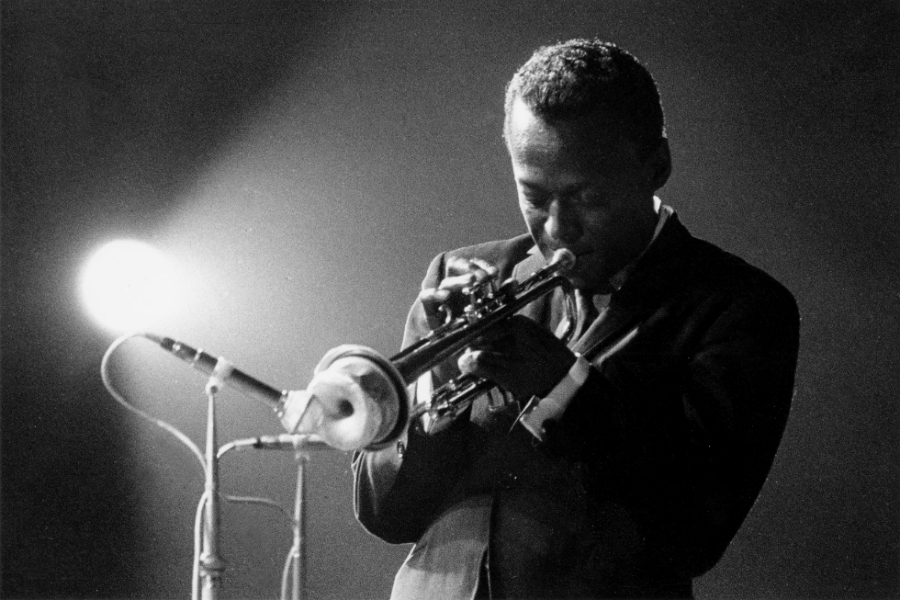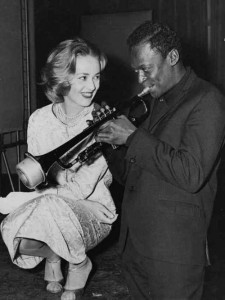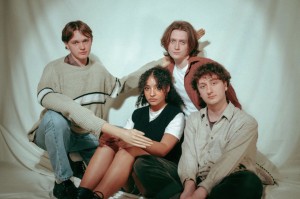Playlist: Miles Davis’ Lift to the Scaffold (1958)

Ahead of a screening and discussion at Cornerhouse tomorrow, Kieran Duffy marvels at the “blisteringly energetic bebop” created for Louis Malle’s New Wave thriller…
The legendary musician Miles Davis was a figure at the forefront of one of the most experimental movements of the last century – Jazz. Davis was a purveyor of bebop (birth of cool), hard bop (walkin’) and modal jazz (kind of blue) in the 1950s, and a pioneer of jazz fusion in the ’70s. The revolutionary spirit of the man makes for an obvious pairing with new French cinema, which, in the late ’50s, was poised to bloom.
Although Director Louis Malle would later distance himself from those at Cahiers du Cinéma, his debut Ascenseur pour l’échafaud/Lift to the Scaffold (1958) bears many of the hallmarks of the French New Wave. Others also spotted what a fruitful relationship jazz and cinema might have together around this time: Charles Mingus with Shadows (1959), Duke Ellington with Anatomy of a Murder (1959) and Chico Hamilton with The Sweet Smell of Success (1957).
Miles Davis’ modal jazz is a particularly wonderful match for the seductive suspense and midnight feel of film noir. Davis’ smoky melodies and effortless sense of cool lends so much to the film in terms of creating mystique and intrigue. However, this music does not just function as an atmospheric backdrop to the film; it is neither incidental, nor superficial window dressing. It is woven into the fabric of the storytelling.
Like the film itself, the score splits into two narratives: the introspective story of Julien and Florence, and the fast and loose adventures of the young lovers Veronique and Louis. At Le Poste Parisien studio in late 1957, the band improvised the score with nothing but some simple direction from Davis and knowledge of the plot. Two distinct thematic strands running alongside each other in the album; one strand is suspenseful and dramatic, offering an essential insight into the psychological and emotional inner workings of the characters; the other reflects a sense of youthful exuberance with blisteringly energetic bebop.
The opening credits roll to the first track Générique; Davis’ trumpet rises gracefully over a gently shifting rhythm section; his silky licks evoking a longing melancholy. He artfully explores a sense of space in ways that he would later do in the classic albums Kind of Blue (1959) and In a Silent Way (1969). The voice of his instrument seems to be coming from a distance; like listening to somebody play alone from two city blocks away; or, as though one of these characters is the trumpeter, contemplating the events of the film. They are retelling the story: weary, heartbroken, their aspirations left in tatters. The seed is planted in the viewer — Florence and Julien are on a somewhat tragic trajectory. By bearing the emotional weight of the narrative as a whole, Davis draws us into the film and into the characters’ minds.
When the reckless Veronique and Louis speed off in a stolen car, the radio plays a restless, scorching, twitchy bebop track, Sur l’autoroute. The band can barely contain Miles’ ecstatic trumpet as it jitters away, spitting out licks with a wild, nervous urgency. The frantic, explosive rhythm captures the motion of the fast car, the mechanisms inside firing off. This loud barrage is the spirit of youth. Bebop, in all its joyous optimism, provides a wonderful accompaniment to a couple of joyriders on the loose. Davis is, delightfully, channelling his mentor, Charlie ‘Yardbird’ Parker, nodding towards the kind of music he was moving away from at this stage in his career.

Elsewhere in the score, specifically on the tracks Julien dans l’ascenseur, Évasion de Julien and Visite du vigile, we have an entirely different approach. Miles’ trumpet playing is pushed, markedly, into the background. These tracks are for the purpose of suspense. Using tempo changes to drive up tension, the rhythm players create an anxious, claustrophobic space. Miles stretches out notes over several bars, like time is standing still (as it does for the character, Julien, trapped in an elevator).
The score really shines, however, as it follows Florence meandering across the city. The beautiful Jeanne Moreau is shot elegantly by Louis Malle; the city literally turns around her, a visual treat. The track Florence sur les Champs-Élysées ensures the ears are treated with equal generosity; Davis’ cool trumpet seems to hang suspended all around the image. You can almost smell the smoke of the seedy nightclubs in the small hours of the day. The piano playing on this track, spacey and understated, is always gently suggesting movement to us. It all seems so effortless, the marriage of style between image and sound absolutely finding its groove in these sequences.
Both Julien and Florence’s narrative arcs are almost without real dialogue, the score becoming essential in telling the story and imbuing the film with a stylish edge. Malle even directs so that it functions as part of the structure of the film; so interwoven with its score, it lays groundwork for the spontaneous, jazz-like structure of Jean-Luc Godard’s films that would follow in the next decade.
As a stand-alone album, Lift to the Scaffold by Miles Davis is really a thing of beauty. It explores tension and suspense. It has raucous bebop freak-outs. It can be sensitive and contemplative. It draws upon Miles Davis’ early oeuvre and, most importantly, it foreshadows some of Davis’ most successful works in Milestones and Kind of Blue. It gives us a sense of Davis forming his most universally praised styles, and for that it holds its own place in his body of work.
Kieran Duffy
Catch Lift to the Scaffold (1958) at Cornerhouse, Manchester tomorrow, Wednesday 2 July, 1.30pm (including a post screening discussion led by Roy Stafford ) — tickets £6/4.50. As part of the cinema’s Matinee Classics Season
Read George Jepson’s In Profile: A Lift to the Scaffold (1958) here
Read more of our articles on film noir here





